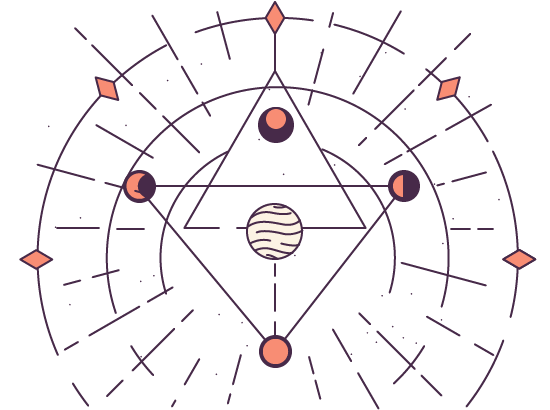KAS FREE COURSE PRIME

About Nakshatras – Four Aim Of Life
2. Artha: Generating income and wealth so you can provide shelter and food for your body.
3. Kaama: going after your desires.
4. Moksha: liberating your soul.
Every Nakshatra represents an energy in which one aim is focused. Therefore, by looking at which planets are in which Nakshatras we can find out which aims of life are focused.
At first sight there seems to be a connection between these aims and the elements. It is easy. Connection between fire and Dharma, earth and Artha, air and Kama, moksha and water.
Now the first Nakshatra Ashwini is a Dharma Nakshatra, the second Nakshatra Bharani is a Artha Nakshatra, the third Krittika is a Kama Nakshatra and the fourth Rohini is a Moksha Nakshatra.
Then however something different happens. The fifth Nakshatra Mrigashirsha is also a Moksha Nakshatra and from then, the order is going backwards. So the sixth Nakshatra Ardra is a Kama Nakshatra, the seventh Punarvasu is an Artha Nakshatra and the eighth Pushya a Dharma Nakshatra.
Now we have returned at the ‘first aim’ Dharma again. The ninth Nakshatra Ashlesha is still a Dharma Nakshatra. From then, we go onwards: the tenth Nakshatra Magha is Artha, the eleventh Purva Phalguni is Kama, the twelfth Uttara Phalguni is Moksha.
From then, the same thing happens as with Rohini. Again the next Nakshatra Hasta is a Moksha Nakshatra and from then, we go backwards: Chitra is Kama, Swati is Artha and Vishakha is Dharma.
As can be expected there follows another Dharma Nakshatra which is Anuradha, then we have an Artha Nakshatra Jyeshta, a Kama Nakshatra Mula and a Moksha Nakshatra Purvashadha.
At this point, something happens which may surprise us. At first what happens is very much what we would have expected. There comes another Moksha Nakshatra, which is Utturashadha, but then we seem to skip the Kama Nakshatra and go right to an Artha Nakshatra which is Shravana and then we come to a Dharma Nakshatra which is Dhanishta.
Of course, it is interesting to know why we skip the Kama Nakshatra. The answer seems to be that in the past there used to be a system of 28 Nakshatras. The 28st Nakshatra is Abhijit. This Nakshatra is located between Purvashadha and Shravana. It is the only Nakshatra of which the main star Vega is located far away from the ecliptic. That is also why it is hard to locate it on the ecliptic and probably one reason why it is skipped.
However, some fifteen thousand years ago Vega used to be the polestar. In the past, this Nakshatra could be very important. The fact that the deity which belongs to this Nakshatra is Brahma, the creator, seems to underline this. Today, this Nakshatra is sometimes used for religious purposes, but it's not a standard part of the system.
Going back to the order of Nakshatras. We have arrived at Dhanistha, which is a Dharma Nakshatra. Now we will find as expected another Dharma Nakshatra, which is Shatabhishak. Then comes an Artha Nakshatra Purva Bhadrapada, a Kama Nakshatra Uttara Bhadrapada and we end with a Moksha Nakshatra Revati.
It is interesting that we start the sequence of Nakshatras with the Nakshatra Ashwini which is a Dharma Nakshatra (that has to do with finding our purpose in life) and end with a Moksha Nakshatra which is about spiritual liberation.



Understanding
Retro Planets
- When any inner planet is in retrograde motion, it is always between the Sun and Earth.
- When any outer planet is in retrograde motion, earth is between the Planet and the Sun.
- Thus, retrograde planets are always near to earth.
- This also means that the Planet’s ray will travel less distance to earth.
- Such planet effect will be felt stronger on earth
- Planet in exalted sign is closest to earth.
- If a planet is exalted and in Retrogradation motion, this becomes most powerful.
Audio Library

All audios are updated in 128kbps quality. Made some additions in these audios. Try to relisten if you have already done it. You will find it more meaningful.
KAS Group

Audio Library
Just a Note
To maintain privacy of personal contents, due consent of participants is obtained for conference audio clips, if any. Try to learn, concentrate & grasp guruji’s words what he exactly means instead of re-recording these audios to listen later. You might be losing real charm. Progress of grasping will probably be slower, and the risk of heading off in a wrong direction could be higher.

TATKARAKVARGAMOOLAT
When we divide this word up, ‘taatkaalik’ (a derivative of ‘tatkarak’) basically means functional karaka, ‘varga’ refers to the Navamsha divisional chart and ‘moola’ refers to the root karaka.

All hands-on audio & shaloka
Planes Classification
Sixth Lord Effect
Barack Obama Chart
Finding Mahadasa Lord
Samdharmi Rules
Jupiter's Rectification
Samroop Planets
Navamsa Houses
Navamsa's Fourth House
More Sectors In Vargas
Marriage Houses
Off Worksheet Results
Planet's Quality
Planets Points Deduction
Blessings - A Shield
Sawodyakal Significance
Timing Upachya Houses
Lord B In MoolHouse
8th Lord In 3rd House
Shaloka Explanations
Multiple Events
Hora Chart
Twin's Chart
Jupiter In Own Signs
Sixteen Divisional Charts
Working with the divisional Charts
Trimshansha
What is the importance of D30 chart. Does this tells us “Arishta” or something more? To learn more this link might be important.
Bhansh
What are the significance and use of the Saptavimansa (D-27) chart. Why was it given the maximum weightage? How is it used, and for what specifically from determining the overall strength ?

Shastyansha
Life time achievements can be seen through this D60 chart. . How to know the direction of someone’s skill in a particular field ?
“Which house represents obsession”


Hora Chart
Study Dasa Quality

Divine Knowledge
Delay In Childbirth
Saturn or samdharmi to Saturn. There can be delay in the child birth.
Click The Image To Open



